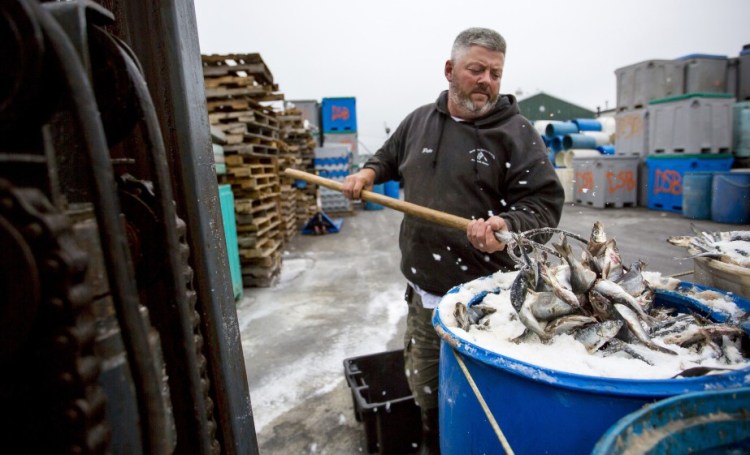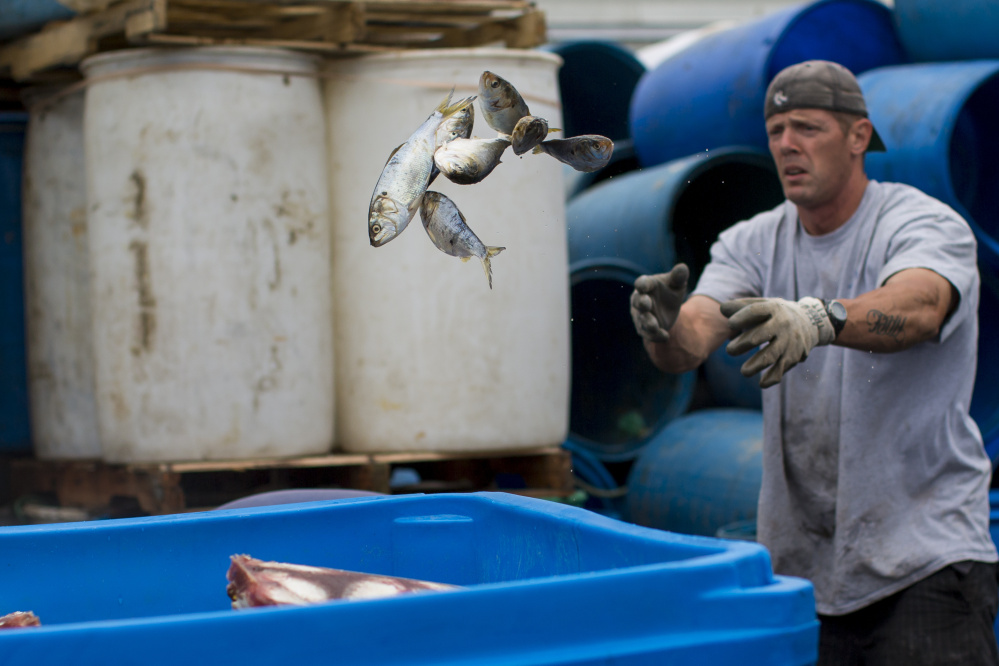State regulators are taking steps to avert a crippling shortage of the most popular bait fish used by Maine lobstermen before the height of the season begins next month.
The dozen offshore trawlers that hunt for Atlantic herring in federal waters off Georges Bank are not catching much yet. In an effort to meet the demand for lobster bait, a few of these larger boats have changed their gear and joined the state’s much smaller, traditional purse seine herring fleet that fishes Maine’s coastal waters, said Deputy Commissioner Meredith Mendelson of the state Department of Marine Resources.
But regulators quickly realized that fishermen were running through the inshore fishing quota too fast, threatening to hit their summer limit before peak lobster season begins in August.
Fishermen have landed about 25 percent of the 19,400 metric tons of herring they are allowed to catch inshore during the summer, Mendelson said. At this time last year, fishermen had only caught about 20 percent of the summer quota.
“We’ve been trying to strike a balance,” she said. “We need to keep the inshore fishery open as long as possible, to get it to last through August so there’s no shortage of bait when lobstermen need it most, but we can’t be too restrictive or we run the risk of having a shortage now, or at least until the offshore boats find their herring. So we took some steps, and those didn’t seem to be enough. We were still running through the inshore quota too fast, so we tried some other things, but now industry is telling us there’s not enough bait. It’s a balancing act.”
On Saturday, after meeting with industry representatives this week, the department will issue new herring rules that will loosen some of the fishing restrictions enacted this spring to try to stretch the inshore summer quota and give the fleet the flexibility that it says it needs to supply a steady but moderate supply of bait. For example, earlier this year, herring fishermen were told they could only fish one day a week, and that wasn’t enough time for them to find the fish, especially in bad weather. Now they will be able to fish three days a week and land fish on two of those days.
CATCH TO BE TIGHTLY MONITORED
But the department also is adopting a weekly landing limit – no more than 600,000 pounds of herring per boat – to make sure this additional flexibility doesn’t drive up the catch to the point of causing a shortage in August. Maine will require landing vessels to inform the department as they come to shore, so staff and the Maine Marine Patrol can monitor and document the catches. That will ensure catches match up with the landings reported by herring dealers to make sure the fleet is not abusing this new flexibility and using too much of the summer quota too early.
“Let me be clear: Whether or not this regulatory approach works is up to the industry,” Marine Resources Commissioner Patrick Keliher said in a letter to herring fishermen, who lobbied him for the new flexibility during a meeting this week. “If there is evidence that landings are not being accurately estimated in good faith after a few weeks of operating under this regulation, I will act swiftly to significantly reduce effort (the amount of fishing allowed) by returning to a single fishing and landing day per week.”
The new regulations will define the types of vessels that can be used to fish for herring and which ones can be used to carry the harvest ashore, which is another way to limit the amount of fish that big offshore boats can land. The state’s traditional inshore fishing boats use a skiff and a net supported by floats to surround and encircle a school of fish found near the surface of the water, which is then drawn together, or “pursed,” to close the bottom.
Regulators, lobstermen and bait dealers all hope the offshore fishing fleet can find the herring they’re hunting to provide the bait that lobstermen and bait dealers are scrambling to get right now, as new shell lobster begin to come out in full force. They also hope to draw the larger boats capable of trawling away from the inshore fishery and back to deeper waters. The latest landing data show Georges Bank-area herring fishermen had caught 8,300 metric tons of baitfish so far this year. That is far behind the 19,113 metric tons of herring they had caught there at this same time last year.
FISHERMEN ACCEPT HIGHER BAIT COST
Lobstermen understand they must pay more for bait now while the offshore catch is low and regulators are trying to preserve the inshore catch for peak season, said Patrice McCarron, executive director of the Maine Lobstermen’s Association.
Although lobstermen prefer herring, because it is local, usually available and it works, they can use other fish for bait, too, such as pogies or redfish. Many of the state’s larger bait dealers have those in supply, as well as salted or frozen herring from Canada. But smaller bait dealers don’t have that kind of storage capacity, leaving some lobstermen scrambling for bait, McCarron said. Lobstermen who don’t live close to one of the “big guy” dealers are probably hardest hit by the shortage, both in availability and by price increases, she said.
“Lobstermen understand their business is dependent on bait supply,” McCarron said. “It’s very frustrating to see the prices go up, but they need bait. Our primary goal is to have a steady supply of bait over a course of the season. We understand the supply has to be tight now, but we’re OK with that as long as it gets us across the season, that we have fresh herring through October.
“We don’t want to tell the herring industry how to fish. It is up to them. They know what works. What we want is predictability, in prices if we can, but in accessibility most of all.”
Copy the Story LinkSend questions/comments to the editors.






Success. Please wait for the page to reload. If the page does not reload within 5 seconds, please refresh the page.
Enter your email and password to access comments.
Hi, to comment on stories you must . This profile is in addition to your subscription and website login.
Already have a commenting profile? .
Invalid username/password.
Please check your email to confirm and complete your registration.
Only subscribers are eligible to post comments. Please subscribe or login first for digital access. Here’s why.
Use the form below to reset your password. When you've submitted your account email, we will send an email with a reset code.